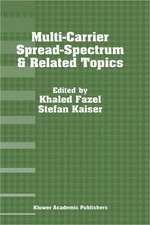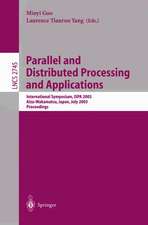Autonomic Computing and Networking
Editat de Mieso Denko, Laurence Tianruo Yang, Yan Zhangen Limba Engleză Paperback – 5 noi 2010
| Toate formatele și edițiile | Preț | Express |
|---|---|---|
| Paperback (1) | 952.89 lei 43-57 zile | |
| Springer Us – 5 noi 2010 | 952.89 lei 43-57 zile | |
| Hardback (1) | 959.19 lei 43-57 zile | |
| Springer Us – 27 mai 2009 | 959.19 lei 43-57 zile |
Preț: 952.89 lei
Preț vechi: 1162.06 lei
-18% Nou
Puncte Express: 1429
Preț estimativ în valută:
182.36€ • 189.68$ • 150.55£
182.36€ • 189.68$ • 150.55£
Carte tipărită la comandă
Livrare economică 14-28 aprilie
Preluare comenzi: 021 569.72.76
Specificații
ISBN-13: 9781441947093
ISBN-10: 1441947094
Pagini: 472
Ilustrații: XIV, 458 p. 75 illus.
Dimensiuni: 155 x 235 x 25 mm
Greutate: 0.66 kg
Ediția:Softcover reprint of hardcover 1st ed. 2009
Editura: Springer Us
Colecția Springer
Locul publicării:New York, NY, United States
ISBN-10: 1441947094
Pagini: 472
Ilustrații: XIV, 458 p. 75 illus.
Dimensiuni: 155 x 235 x 25 mm
Greutate: 0.66 kg
Ediția:Softcover reprint of hardcover 1st ed. 2009
Editura: Springer Us
Colecția Springer
Locul publicării:New York, NY, United States
Public țintă
ResearchCuprins
Section 1 Autonomic Computing.- General-Purpose Autonomic Computing.- Software Architecture-Based Self-Adaptation.- Mobile Agent Middleware for Autonomic Data Fusion in Wireless Sensor Networks.- Component-Based Autonomic Management for Legacy Software.- Dynamic WSDL for Supporting Autonomic Computing.- Bio-inspired Cognitive Radio for Dynamic Spectrum Access.- Introducing Autonomous Behaviors into IMS-Based Architectures.- Embodied Cognition-Based Distributed Spectrum Sensing for Autonomic Wireless Systems.- Autonomic Peer-to-Peer Systems: Incentive and Security Issues.- Section 2 Autonomic Networking.- Toward Autonomic Networks: Knowledge Management and Self-Stabilization.- Autonomic Networking in Wireless Sensor Networks.- iNetLab: A Model-Driven Development and Performance Engineering Environment for Autonomic Network Applications.- Network Reconfiguration in High-Performance Interconnection Networks.- Autonomic Management of Networked Web Services-Based Processes.- Concepts for Self-Protection.- Formal Aspects of Self-#x0002A; in Autonomic Networked Computing Systems.- Autonomic Information Diffusion in Intermittently Connected Networks.- Dynamic and Fair Spectrum Access for Autonomous Communications.
Textul de pe ultima copertă
Autonomic Computing and Networking serves as a technical guide and reference material for engineers, scientists, practitioners, and researchers by providing them with state-of-the-art research activities and future opportunities and trends. The contributions made by prominent researchers from academia and industry include state-of-the-art architectures, protocols, technologies, and applications in pervasive computing and wireless networking. In particular, the book covers existing and emerging communications and computing models, design architectures, mobile and wireless applications, technology and research issues in autonomic computing systems and communications.
Important features include:
Important features include:
- A comprehensive reference on autonomic computing and networking,
- State-of-the-art techniques used in the field,
- Illustrative figures enabling easy reading, and
- Emerging trends and open research problems and issues.
Caracteristici
Introduces the first compiled state-of-the-art research findings, technologies, tools and innovations that provide sufficient reference material for researchers and practitioners in industry and academia Provides a comprehensive technical guide covering the introductory and advanced concepts that can serve as a reference material to graduate students in the fields of computing, engineering and computer engineering Provides detailed discussions on key research challenges and open research issues that are of great importance to graduate students and practitioners who intend to do research and contribute to the achievement of the goal of autonomic computing and networking Serves as a guideline and gives insights to professional and industrial standards organizations for developing future standards in autonomic computing, communications and networking Provides valuable information on existing experimental studies including case studies, simulation tools and implementation testbeds in industry and academia that can be used for validation of theories and analytical results by researchers and practitioners at various levels Contains illustrative figures enabling easy reading. Includes supplementary material: sn.pub/extras



















